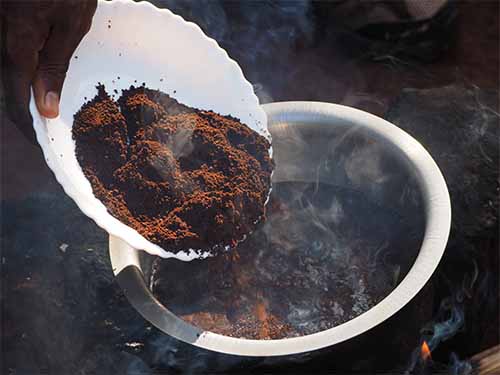Discovering the Gaggia Classic: Your Ultimate Guide to Espresso Machines
If you’re venturing into the world of espresso, you’ve likely come across the Gaggia Classic. Renowned for its reliability and exceptional quality, the Gaggia Classic


The origins of coffee can be traced back to the ancient kingdoms of Ethiopia, where legend has it that a goat herder named Kaldi discovered the effects of the coffee plant on his goats. According to the story, Kaldi noticed that his goats became more energetic after eating the berries of a certain plant. Intrigued, he tried the berries himself and found that they had a similar effect on him. He shared his discovery with the local monks, who began to use the berries to create a stimulating drink that helped them stay awake during long religious ceremonies.
In ancient Ethiopia, coffee was primarily consumed in the form of a ceremonial beverage, and it played an important role in religious and social events. Coffee ceremonies were often held in the home, and the preparation and consumption of coffee was a ritualistic process that involved roasting the beans over an open flame, grinding them, and then brewing the coffee in a clay pot called a jebena. The coffee was typically served in small cups and was often accompanied by the burning of incense and the serving of popcorn.
Ethiopian coffee was also considered to be a valuable trade commodity, and it was traded with neighboring kingdoms and countries. It was also used as a form of currency and was used to pay taxes and wages.
It is interesting to note that, even today, coffee is deeply ingrained in Ethiopian culture, and it remains a central part of social gatherings and daily life, with traditional coffee ceremonies still being a common practice. In addition, Ethiopia remains one of the largest coffee-producing countries in the world, and its beans are considered to be some of the finest in terms of taste and quality.
From Ethiopia, the use of coffee spread to the neighboring Arabian Peninsula.

The history of coffee in the Arabian Peninsula dates back to the 15th century, where it is believed to have been first discovered by Sufi monks in the region. They observed that the beans of the coffee plant had a stimulating effect and began to use it as a way to stay awake during prolonged periods of prayer.
Coffee quickly spread throughout the Arabian Peninsula, and by the 16th century, it had become a popular beverage in cities such as Mecca, Medina, and Cairo. The first coffeehouses, known as “qahveh khaneh,” were established in Mecca and quickly became popular gathering places for scholars, poets, and politicians.
As coffee consumption grew, it also played a significant role in the economic development of the region. The Arab world became a major producer and exporter of coffee, and the trade of coffee beans became an important source of income for many families.
Coffee also played an important role in the cultural and intellectual life of the region. Coffeehouses were not only a place to enjoy a cup of coffee but also served as centers of cultural and intellectual exchange, where people could discuss literature, philosophy, and politics.
As the popularity of coffee grew in the Islamic world, it began to spread to other parts of the globe.

In the 17th century, coffee was first introduced to Europe and quickly became a popular drink among the upper class. Initially, it was primarily consumed in the form of a medicinal beverage and was prescribed for a variety of ailments. The first coffeehouse in Europe was opened in Venice in 1683, and from there, the trend quickly spread to other major cities such as London, Paris, and Amsterdam. These coffeehouses were often located in central areas and were popular places for intellectual and political discussions, as well as for conducting business. They were also a place where people could enjoy coffee and socialize, which was different from the traditional pubs and taverns.
During this time, coffee was quite expensive, and the beans had to be imported from the Middle East and Africa, where they were grown. As a result, it was a luxury item and was primarily consumed by the wealthy. However, by the end of the century, coffee had become more widely available, and coffeehouses were a common sight in many European cities.
Coffee was also consumed in private homes, but it was typically prepared by servants and consumed by the upper class. The coffee brewing process was quite complex and time-consuming, involving roasting the beans, grinding them, and then brewing them in a special pot known as a “coffee pot.”

The history of coffee in the Americas dates back to the 18th century, when the first coffee plants were brought to the Caribbean island of Martinique by a French naval officer. These plants were then transported to other Caribbean islands, such as Jamaica and Haiti, where they were grown on large plantations.
In the early 19th century, coffee production began to spread to other parts of the Americas, including Central and South America. The first coffee plantation in Central America was established in El Salvador in 1835, and soon after, coffee became one of the main agricultural products in countries such as Costa Rica, Colombia, and Brazil.
As coffee production grew, it also played a significant role in the economic development of the region. Coffee became a major export for many countries in Central and South America, and the trade of coffee beans became an important source of income for many families.
In the United States, coffee consumption began to rise in the late 18th century, and by the mid-19th century, it had become a staple of American society. The first American coffeehouse was established in New York City in 1793, and soon after, coffee shops and saloons began to appear in cities throughout the country.
Over the centuries, coffee has undergone many changes. In the early days, coffee was consumed primarily in the form of a bitter drink made from roasted and ground coffee beans mixed with water. However, as coffee spread around the world, new brewing methods and flavourings were developed. For example, in the 19th century, coffee was often flavoured with spices such as cinnamon and nutmeg, and in the 20th century, new brewing methods such as drip brewing and espresso machines were developed. Today, there are many different ways to brew and flavour coffee, and it is consumed by people of all walks of life all over the world.
Coffee also has a significant economic impact and has grown to be one of the most important traded commodities in the world. Today, coffee is grown in many countries around the world, with the largest producers being Brazil, Vietnam, Colombia, and Indonesia. The coffee industry employs millions of people and generates billions of dollars in revenue each year.
If you’re venturing into the world of espresso, you’ve likely come across the Gaggia Classic. Renowned for its reliability and exceptional quality, the Gaggia Classic

Nothing beats the sensation of that first sip. A new coffee flavour you’ve never tried before — and now it’s all yours. As the caramel

Coffee – it’s more than just a morning pick-me-up; it’s a journey of discovery. For many, the quest for the perfect cup begins with the

In 2020, something huge happened. The COVID19 pandemic and ensuing lockdowns created an opportunity for people to explore making coffee at home. Coffee machine sales

Nestled on the picturesque South Island of New Zealand, Christchurch is a vibrant city that boasts a thriving coffee culture. With its array of trendy

As coffee enthusiasts, we understand the significance of that first sip in the morning or the delightful mid-afternoon pick-me-up. At Bean Merchant, we pride ourselves
Copyright ©️ 2024 Bean Merchant. All Rights Reserved.
We do not hold financial information, all secure data is encrypted via Stripe.
Try our unique coffee flavour profiling quiz to find your perfect coffee beans.
Bean Merchant is New Zealand’s most relied upon curator for home coffee delivery. Whatever coffee flavours you are after, we have the widest variety to choose from.